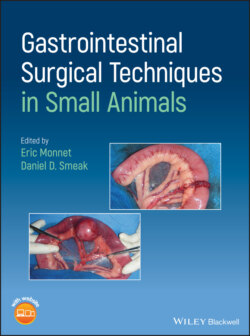Читать книгу Gastrointestinal Surgical Techniques in Small Animals - Группа авторов - Страница 35
2.1.6 Suture Needles
ОглавлениеSurgical needles are constructed of surgical grade stainless steel, and they have three basic parts, the suture attachment (swag), body, and needle point (Table 2.2). Needles chosen for use in gastrointestinal surgery are of the swaged‐on variety (permanently crimped to the suture material).
The body of needles used for most gastrointestinal surgeries are curved. The “flatter” curve of the 3/8 circle needle is best for suturing on surfaces that are superficial and readily exposed to the surgeon. Curved needles with great arc (1/2 and 5/8) are more suited for suturing small, deeper wounds in more confined areas.
Needle points can be divided into cutting, taper, or taper‐cut types. Cutting needles possess sharp points (two opposing cutting edges and a third edge along the outer curvature (reverse cutting) or the inside of the curvature (conventional cutting)). Both types of cutting needles are triangular on cross‐section, but the reverse cutting is most popular because it is 32% stronger, and it resists cut‐out during tissue passage due to the flat nature of the inner curvature. Cutting needles readily penetrate tough, heavily collagenous tissues such as gingiva. Taper point needles are round on cross‐section, and result in less tissue trauma, and smaller tissue punctures than cutting point needles. They are the preferred needle type for most gastrointestinal procedures. Taper‐cut needles combine the cutting action of the triangular shaped point, and the round body of the taper needle for atraumatic passage through delicate tissues. These needles are often chosen for mucogingival repairs, or when a friable tissue edge is sutured to tough skin or mucoperiosteum (Domnick 2014).
